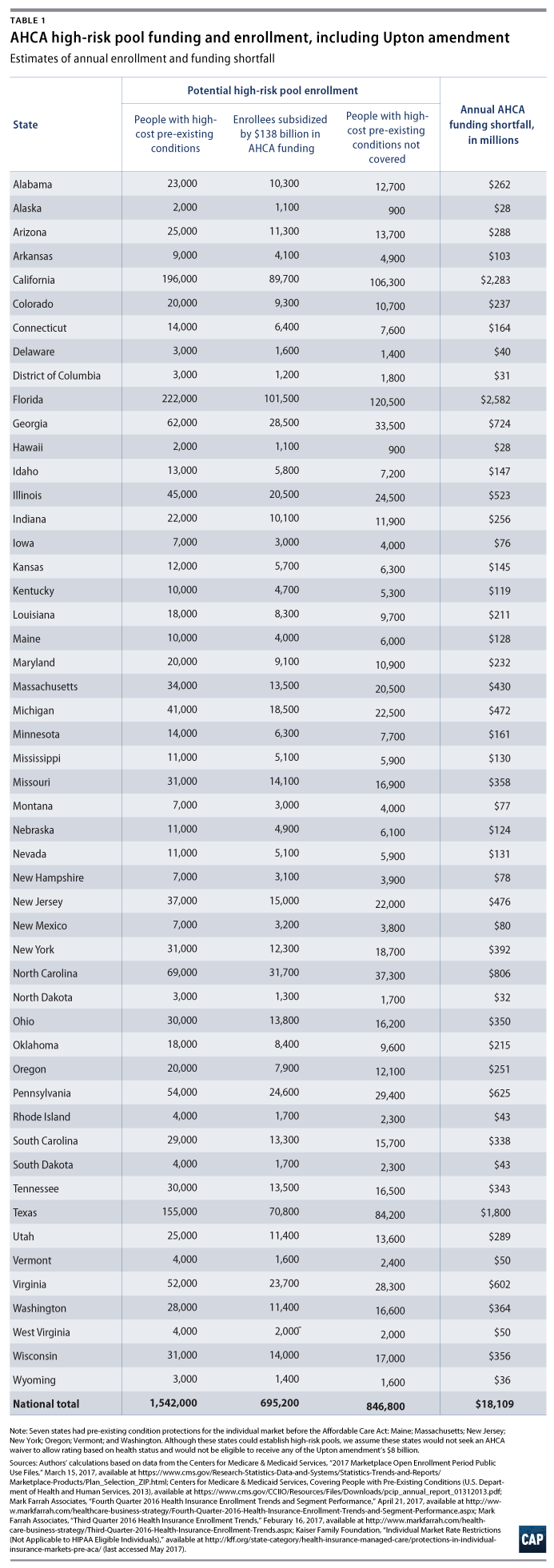House Republicans are proposing to invest additional money in bad policy. Moderate members have been offered $8 billion more in the American Health Care Act, or AHCA, that could help fund high-risk pools for people with pre-existing conditions, a policy that has failed to provide adequate health coverage in the past. With the deal, up to $138 billion could go to high-risk pools under the AHCA, but that additional $8 billion would subsidize just 76,000 more people.
The high-risk pool plan is an attempt to cover up for another provision in the bill, via an amendment by New Jersey Rep. Tom MacArthur (R), that would allow states to easily waive protections for Americans with pre-existing conditions in the individual market if they experienced a gap in coverage.
The Center for American Progress found that the $130 billion of funding already in the AHCA would be insufficient to sustain even a small high-risk pool. Supposing the size of the pool was about 5 percent of the small-group and individual markets, the AHCA would need to provide a total of $327 billion to offer moderately subsidized high-risk pool coverage for those 1.5 million people. The current version of the AHCA falls $200 billion short of that, and the $8 billion promised to House Republican moderates would fill in just 4 percent of the funding gap.
Suppose that the high-risk pool’s enrollees would receive Affordable Care Act-like benefits, including limits on out-of-pocket costs, no rating based on health status, coverage of essential health services, no annual or lifetime limits, and a subsidy that covers 68 percent of the average premium. We start our calculations by assuming that the average high-cost enrollee has annual claims of $32,108, the average in the Affordable Care Act’s transitional Pre-Existing Condition Insurance Plan. We then subtract the consumers’ share of medical costs from the total claims cost and add health insurance companies’ administrative overhead. The resulting premium for the AHCA high-risk pool would be $31,000 per year. A 68 percent subsidy would be $21,000—hardly generous considering that the consumer’s share of the premium would be $10,000.
Two moderate Republicans, Rep. Fred Upton (R-MI) and Rep. Billy Long (R-MO), have reportedly been promised that the AHCA will put an additional $8 billion toward high-risk pools over five years, for an average of $1.6 billion in funding per year. The money could be limited to states that choose to waive pre-existing condition protections. Assuming moderately generous premium subsidies of $21,000 per year for high-cost coverage, the Upton amendment could help cover 76,000 enrollees—a tiny fraction of the 130 million Americans with pre-existing conditions.
The full $138 billion would subsidize about 700,000 people annually, including the 76,000 from the Upton amendment, in a high-risk pool. But if roughly 5 percent of current individual market and small-group enrollees needed coverage through the high-risk pools, more than 800,000 people with high-cost health conditions would still be left without protection or affordable coverage. We show estimates by state in the table below. We assumed that states which outlawed health-based rating in the individual market would not waive pre-existing condition protections under the AHCA and would therefore be ineligible for Upton amendment funds.

Note that our estimates have made generous assumptions about the maximum funding available for the AHCA high-risk pool. For a full $138 billion toward the risk pool, money would need to be redirected away from other AHCA programs, including promotion of preventive services; the federal invisible risk-sharing program; and maternity care, newborn care, mental health care, and substance use disorders. The entirety of the bill’s Patient and State Stability Fund would need to be dedicated solely to the third option in its list of possible purposes: “reducing the cost for providing health insurance coverage in the individual market and small group market … to individuals who have, or are projected to have, a high rate of utilization of health services.”
House Republican leaders have been presenting the latest ACHA plan as a deal: In exchange for moderate Republicans in the House backing the MacArthur amendment, they sink more money into high-risk pools. But as often happens in trade-offs, there would be winners and losers. Even if the Upton amendment wins votes, the staggeringly large funding gap could leave many Americans with pre-existing conditions stranded outside the high-risk pool without affordable options for coverage.
Emily Gee is a Health Economist at the Center for American Progress. Topher Spiro is the Vice President for Health Policy and a Senior Fellow at the Center for American Progress.